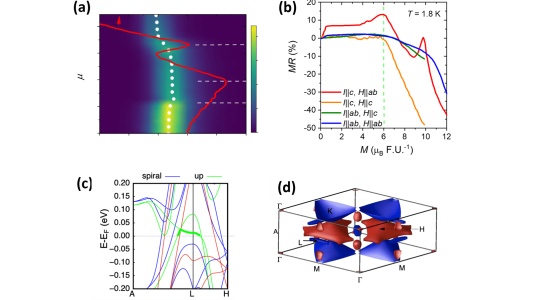
Scientific Achievement
We have discovered a rare magnetization-driven Lifshitz transition (LT) in YMn6Sn6 and connect it with the response of a quasi-flat band to magnetic field.
Significance and Impact
Our findings provide a novel example of how magnetism can influence electronic band structure when a sublattice magnetization drives an abrupt change of the Fermi surface topology.
Research Details
- Large (50%) drop of magnetoresistance (MR) without a change in magnetic structure
- Magnetic order rearranges band structure to align a flat band at the Fermi level, absent in the unmagnetized state. This is a topological transition without symmetry-breaking, or a Liftshitz transition.
- Small angle neutron scattering (SANS) verifies no change in magnetic structure at the LT.
Argonne National Laboratory seeks solutions to pressing national problems in science and technology. The nation’s first national laboratory, Argonne conducts leading-edge basic and applied scientific research in virtually every scientific discipline. Argonne researchers work closely with researchers from hundreds of companies, universities, and federal, state and municipal agencies to help them solve their specific problems, advance America’s scientific leadership and prepare the nation for a better future. With employees from more than 60 nations, Argonne is managed by UChicago Argonne, LLC for the U.S. Department of Energy’s Office of Science.
The U.S. Department of Energy’s Office of Science is the single largest supporter of basic research in the physical sciences in the United States and is working to address some of the most pressing challenges of our time. For more information, visit https://energy.gov/science.